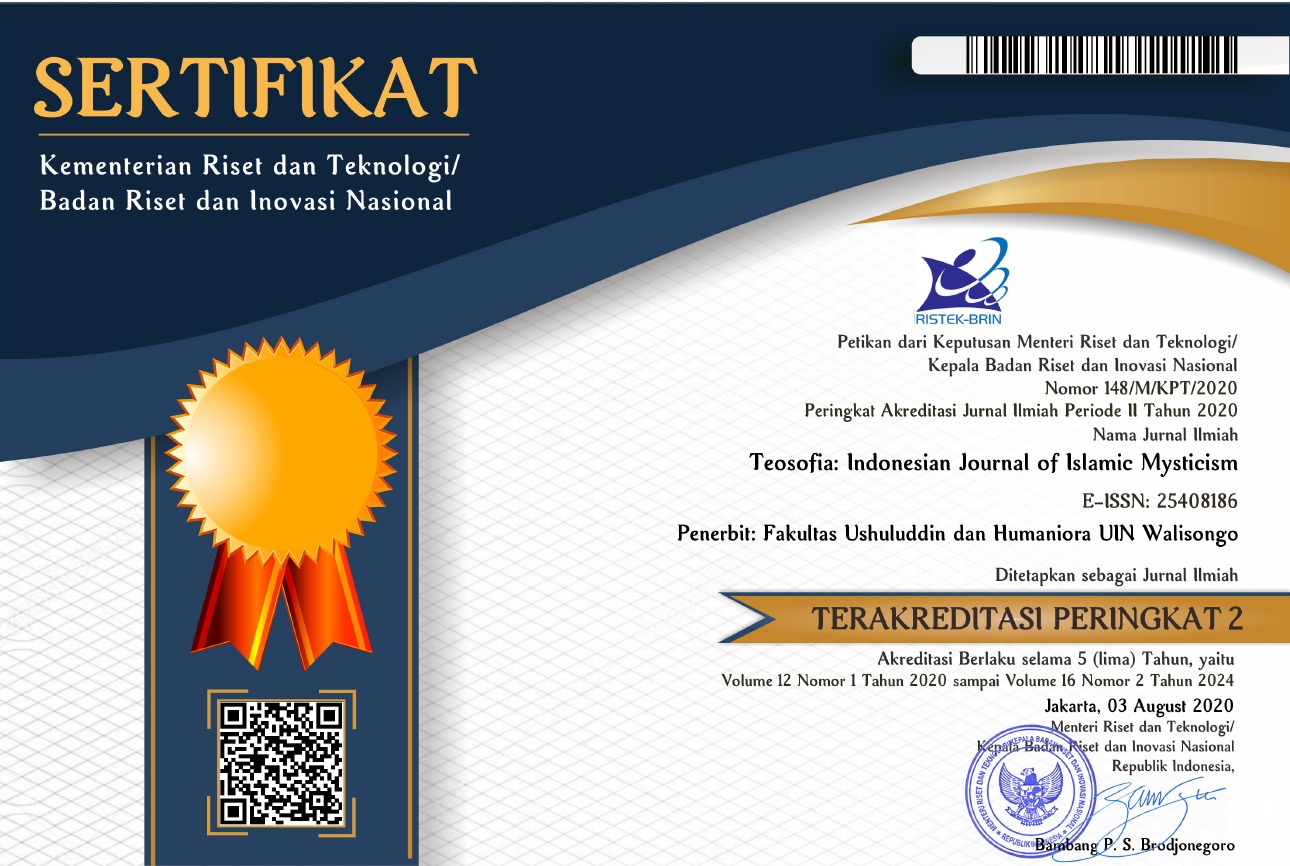Applying Ibn ʿArabī's Concept of Tajallī: A Sufi Approach to Environmental Ethics
DOI:
https://doi.org/10.21580/tos.v10i1.7204Keywords:
Ibn ͑Arabi, Sufism, Tajallī, Environmental Ethics, Environmental ConservationAbstract
This article examines the Sufi concept of tajallī and its application to environmental ethics. This study usesdescriptive and productive interpretation to analyze the data which are extracted from the main works of Ibn ͑Arabī, namely Fuṣūṣ al-Ḥikam and al-Futūḥāt al-Makkiyya. It finds that Ibn ʿArabī’s concept of tajallī can be understood not only in its philosophical sense but also in its spiritual and moral sense to develop a new approach to environmental ethics. This research has valid implications for taking a new direction in the study of mystic Islam and environmental ethic by incorporating tajallī and other Sufi doctrines such as waḥdat al-wujūd, maḥabbah, and maʿrifah.Downloads
References
Affifi, Abul Ela. The Mystical Philosophy of Muhyid Dín-Ibnul ʻArabí. Cambridge: Cambridge University Press, 1939.
Ahmad, Maghfur. “Three Sufi Communities Guarding the Earth: A Case Study of Mitigation and Adaptation to Climate Change in Indonesia.” Al-Jami’ah: Journal of Islamic Studies 57, no. 2 (December 24, 2019): 359–96. https://doi.org/10.14421/ajis.2019.572.359-396.
Al-Hafni, ’Abd al-Mun͑im. Mu’jam Al-Mustalahat Al-Sufiyah. Beirut: Dar al-Masirah, 1987.
Al-Jilli, Ibrahim. Al-Insan Al-Kamil. Beirut: Dar al-Kutub al-Ilmiyah, 1997.
Amin, Mochammad Lathif. “Eko-Sufisme Islam Aboge Masjid Saka Tunggal Cikakak Banyumas.” Jurnal Penelitian 14, no. 2 (June 27, 2017): 131–50. https://doi.org/10.28918/jupe.v14i2.1212.
Bashier, Salman. The Story of Islamic Philosophy: Ibn Tufayl, Ibn Al-’Arabi, and Others on the Limit between Naturalism and Traditionalism. Albany, NY: Suny Press, 2012.
Bauman, Whitney A, Richard Bohannon, and Kevin J O’Brien. Grounding Religion: A Field Guide to the Study of Religion and Ecology. New York: Taylor & Francis, 2017.
Buana, Cahya. “Nature Symbols and Symbolism in Sufic Poems of Ibn Arabi.” KARSA: Journal of Social and Islamic Culture 25, no. 2 (January 7, 2018): 434–56. https://doi.org/10.19105/karsa.v25i2.1304.
Chittick, William C. The Self-Disclosure of God: Principles of Ibn Al-’Arabi’s Cosmology. Albany, NY: Suny Press, 1998.
———. The Sufi Path of Knowledge: Ibn Al-Arabi’s Metaphysics of Imagination. Albany, NY: Suny Press, 1989.
Chodkiewicz, Michel. An Ocean without Shore: Ibn Arabi, the Book, and the Law. Suny Press. Albany, NY, 1993.
Coates, Peter. Ibn ‘Arabi and Modern Thought. Oxford: Anqa Publishing, 2002.
Corbin, Henry. Creative Imagination in the Sufism of Ibn ’Arabi. Vol. 91. London: Routledge, 2013.
ʻAṭṭār, Farīd al-Dīn. Mantiq Ut-Tair. Boulder, Colorado: Shambhala Publications, 1971.
Izutsu, Toshihiko. A Comparative Study of the Key Philosophical Concepts in Sufism and Taoism: Ibnʻarabı̄ and Lao-Tzŭ, Chuang-Tzŭ. Vol. 7. Tokyo: Keio Institute of Cultural and Linguistic Studies, 1966.
Jalali, Ahmad. “Jalaluddin Rumi’s Religious Understanding: A Prelude to Dialogue in the Realm of Religious Thought.” Diogenes 50, no. 4 (November 26, 2003): 127–34. https://doi.org/10.1177/03921921030504016.
Llewellyn, Vaughan-Lee, ed. Spiritual Ecology: The Cry of the Earth. California: The Golden Sufi Center, 2013.
Morris, James Winston. “Ibn ʿArabi and His Interpreters Part II (Conclusion): Influences and Interpretations.” Journal of the American Oriental Society 107, no. 1 (January 1987): 101–9. https://doi.org/10.2307/602957.
N.S, Suwito. “Eko-Sufisme Studi Tentang Usaha Pelestarian Lingkungan Pada Jama’ah Mujahadah Ilmu Giri Dan Jama’ah Aoliya’ Jogjakarta.” Universitas Islam Negeri Syarif Hidayatullah Jakarta, 2010.
Nasr, Ḥusain, and Seyyed Hossein Naṣr. Religion and the Order of Nature. Oxford: Oxford University Press, 1996.
Nasr, Seyyed Hossein. An Introduction to Islamic Cosmological Doctrines. Britain: Thames and Hudson Ltd, 1978.
———. Islam and the Plight of Modern Man. London; New York: Longman, 1975.
———. Man and Nature: The Spiritual Crisis of Modern Man. Chicago: ABC International Group, 1997.
———. Religion and the Order of Nature. Oxford: Oxford University Press, 1996.
Nasr, Seyyed Hossein, and Oliver Leaman. History of Islamic Philosophy. Vol. 1. England, UK: Routledge, 2013.
Netton, Ian Richard. “An Ocean without Shore: Ibn ‘Arabī, the Book and the Law. By Michel Chodkiewicz, Translated from the French by David Streight. Pp. Xiii, 184. Albany, NY, State University of New York Press, 1993. £12.95.” Journal of the Royal Asiatic Society 5, no. 1 (April 24, 1995): 102–102. https://doi.org/10.1017/S1356186300013572.
Niksirat, Abdollah. “Suhrawardi: A Philosopher Who Must Be Re-Known!” Journal of History Culture and Art Research 5, no. 4 (January 5, 2017): 686–94. https://doi.org/10.7596/taksad.v5i4.638.
Noer, Kautsar Azhari. Ibn Al-’arabi: Wahdat Al-Wujud Dalam Perdebatan. Jakarta: Paramadina, 1995.
Schimmel, Annemarie. Dimensi Mistik Dalam Islam. Translated by Sapardi Djoko Damono and Achadiati Ikram. Jakarta: Pustaka Firdaus, 1986.
Tucker, Mary Evelyn, and Duncan Ryuken Williams. Buddhism and Ecology: The Interconnection of Dharma and Deeds. Cambridge, MA: Harvard University Center for the Study of World Religions, 1997. https://repository.library.georgetown.edu/handle/10822/899108.
Winkel, Eric. “La Estructura Geométrica de Los Grados En El Universo de Los Estados Espirituales.” El Azufre Rojo, no. 3 (January 1, 1970): 89–118. https://doi.org/10.6018/azufre.274031.
ʿArabī, Muhyī al-Dīn Ibn. Fuṣūṣ Al-Ḥikam; Al-Futûhât Al-Makiyyah. Beirut: Dâr al-Kutub al-Ilmiyyah, 2011.
———. Fuṣūṣ Al-Ḥikam. II. Beirut: Dār al-Kutub al-ʿIlmīyah, 2006.
Downloads
Published
How to Cite
Issue
Section
License
Copyright
The copyright of the received article shall be assigned to the journal as the publisher of the journal. The intended copyright includes the right to publish the article in various forms (including reprints). The journal maintains the publishing rights to the published articles. Therefore, the author must submit a statement of the Copyright Transfer Agreement.*)
Licensing

This work is licensed under a Creative Commons Attribution-ShareAlike 4.0 International License.
In line with the license, authors are allowed to share and adapt the material. In addition, the material must be given appropriate credit, provided with a link to the license, and indicated if changes were made. If authors remix, transform or build upon the material, authors must distribute their contributions under the same license as the original.
_______
*) Authors whose articles are accepted for publication will receive confirmation via email and send a Copyright Transfer Agreement.








